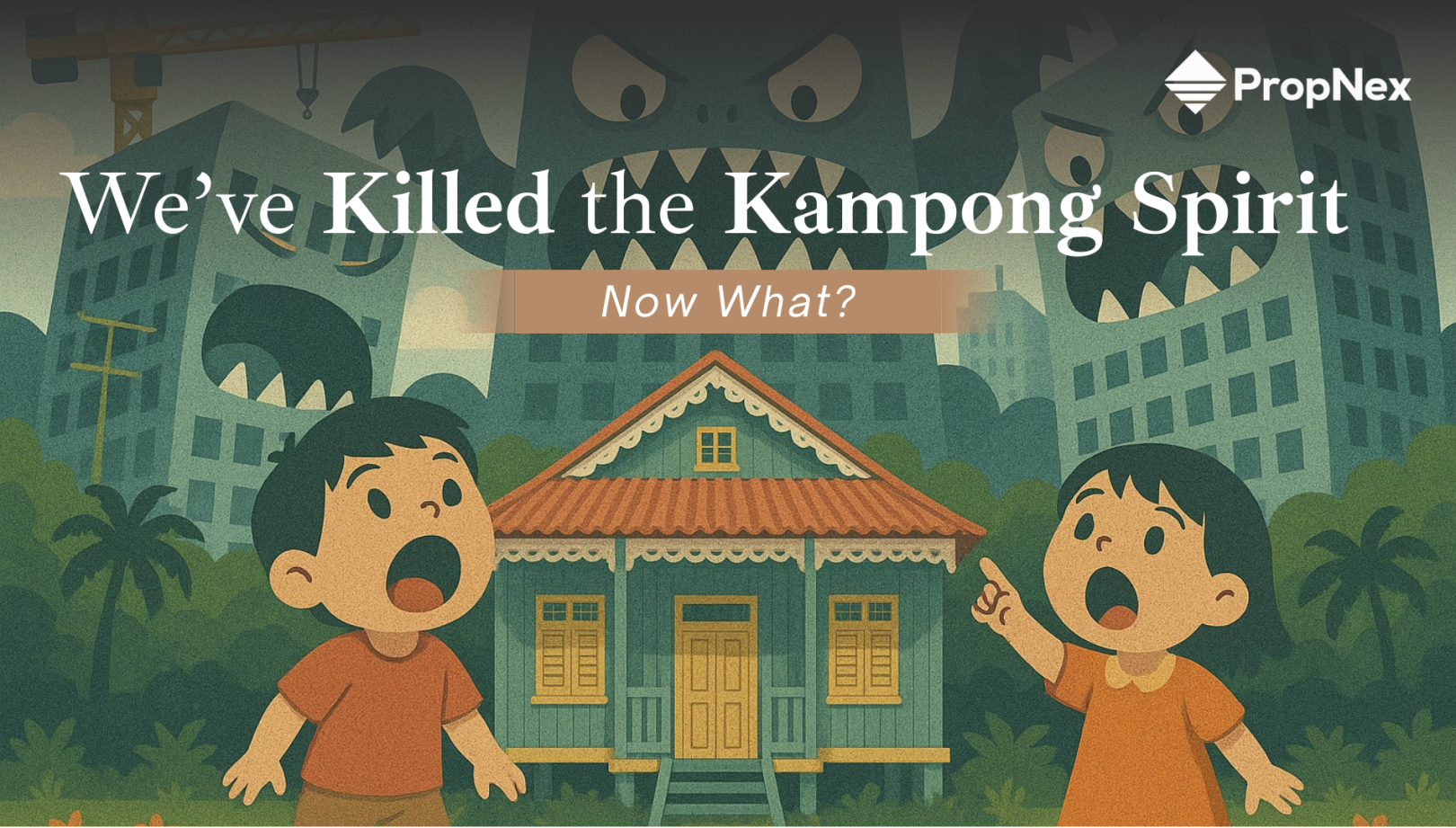PropNex Picks
|April 25,2025We've Killed the Kampong Spirit, Now What?
Share this article:

Before we had towers of modern flats and apartments, people lived in kampongs, small villages where everyone knew each other. Life was much simpler back then. But these villages were more than just traditional houses with attap roofs. They were communities built on a foundation of trust, friendship, camaraderie, belonging, and unity.
They had a way of life known as gotong royong, where neighbours looked out for one another like family. They shared meals together and watched each others' children. Help always came before it was even asked for. Everyone had a role to play, and no one was ever left behind.
Source: roots.gov.sg
Then, Singapore transformed into a metropolis and the kampongs disappeared, replaced by modern housing. But, this new comfort has created physical and emotional distance between neighbours. Sad to say, we've murdered the Kampong spirit.
When was the last time you helped out a neighbour? Talk to them? Do you even know their names? Well, it's not just you.
In 2018, a survey by HDB involving approximately 7,800 households revealed that there has been a decline in neighbourly interactions among residents since 2013.
Exchanging Greetings: 98.6% -> 97%
Engaging in Casual Conversations: 97% -> 94.4%
Keeping Watch Over Neighbour's Flat: 44.6% -> 37.8%
Visiting or Exchanging Food/Gifts: 57.8% -> 52.9%
Exchanging Suggestions or Advice: 27.5% -> 22.1%
Helping to Look After Children: 8.7% -> 7.2%
Helping to Buy Groceries: 15.2% -> 13.5%
Providing or Receiving Financial Help: 2.5% -> 2.2%
The numbers don't lie. We've stopped looking out for one another. You're lucky if you get so much as a polite nod in the lift.
Singapore's housing journey is a clear reflection of our nation's progress. While the kampong spirit is fondly remembered, its lifestyle came with real challenges. Homes made of wood and attap were vulnerable to fires and floods. There was no plumbing or proper sanitation, and daily life involved fetching water and dealing with overcrowded, unsanitary conditions.
All of that began to change in 1960, when the HDB was established to tackle a severe housing crisis. The early flats were modest but offered a huge leap in safety and hygiene, giving Singaporeans a stable place to call home.
As Singapore grew, so did the aspirations of its people. Thus, the evolution of HDBs began. By the 80s and 90s, towns like Tampines and Woodlands started to offer larger flats, improved designs, and integrated amenities. The 2000s saw the rise of Executive Apartments and Maisonettes for families seeking more space. Today, smart towns like Tengah and Punggol Northshore reflect a shift towards sustainability, technology, and community-centric design.
HDB flats have also become stepping stones to greater financial security. Many first-time buyers use their flats to build equity, eventually upgrading to larger homes or Executive Condominiums (ECs). The resale market, especially in older estates, has seen flats fetch over million dollars, showing the potential of public housing as both a home and an asset.
We've come a long way. Not just in how we live, but in how we grow as a community. Yet, while we've gained so much in terms of comfort, safety, and convenience, some may wonder if the warmth of kampong life has been left behind. The way I see it, the kampong spirit doesn't have to disappear, it just needs to adapt.
Today, many people value their privacy and alone time. That's why properties in serene and peaceful locations sell really well these days. So it's safe to say that the kampong way of life may never return in its original form. Even so, that doesn't mean we can't revive its spirit. We just have to adapt it to the digital age.
With more people finding connection through social media, being a neighbour isn't as simple as living nextdoor anymore. While community spaces still help bring people together, we must also embrace the power of online and virtual communities in keeping the kampong spirit alive. Aside from Facebook community pages and Telegram groups there are also platforms like SGKampung and HDB's NUKampung mobile apps that allow neighbours to offer help, share recommendations, and get updates on organised events. Essentially, neighbours can connect with each other and participate in the community, even if they don't meet face-to-face.
Though it's not the same as sharing meals in actual kampongs, these are still valid ways to connect and build a support system at your own pace and comfort level.
On top of that, many HDB towns are actually designed to encourage interaction, with communal areas like terraces, rooftop gardens, and town squares where residents can gather. HDB has also been boosting community-building efforts in the past decade by organising activities like welcome parties and HDB's good Neighbours Awards. Then, there's the Lively Places Programme, which was launched to support community-driven projects. This programme provides up to $20,000 in funds for initiatives that enhance public spaces and foster community bonds. Such projects empower residents to take ownership of their living environments and contribute to a vibrant community life.
Looking at some stories online, it seems that there's still hope for the kampong spirit. Take Seven Lim for example. For years, he barely knew his neighbours. He just politely nodded in passing. But everything changed in October 2022, when a Home Improvement Programme (HIP) project brought an unexpected opportunity.
Source: Singapore Kindness Movement
As residents waited outside their homes during the renovations, small talk turned into real conversations. That was when Steven had an idea: why not celebrate the end of the project together? To his surprise, his neighbours agreed, and in January 2023, they held their first gathering.
That one gathering turned out to be a catalyst of something bigger. Since then, four households on his floor have become as good as family. They celebrate birthdays, Chinese New Year, and Christmas together. They've even traveled together to Malacca and South Korea!
But beyond the celebrations, real friendships have formed. When Steven's elderly mother, who has dementia, got lost at the market, his neighbour Paul stepped in to help her home. And when Paul fell ill, Steven was the one who drove him to the hospital.
Steven's story has since gone viral on social media, inspiring others to take small steps toward building their own communities. His message is simple: you don't need a big event to start. Just a hello, a smile, or a simple act of kindness. Sometimes, that's all it takes to turn strangers into friends, and even family.
The true kampong spirit can also be found in Bedok Reservoir. Sandy Goh was there for anyone who needed help, she checked on elderly residents, and she made sure no one ate alone. She also organised volunteer events to help distribute donated items to those in need in her neighbourhood and surrounding areas. Over time, her kindness inspires others, creating a community where neighbours look out for one another. It's not just about grand gestures, but also the little things.
Today, residents in her estate lend their hands to carry groceries, share home-cooked meals, and even tend to a community garden together. What started as one person's effort has blossomed into a close community of people who genuinely care for each other.
The truth is, we'll never go back to kampong days. But we don't have to, and maybe we don't want to (I'm sure all the fellow introverts are with me when I say this). The kampong spirit isn't about the kampong itself. Rather, it's a mindset and a way of life that thrives when people choose to connect, care, and look out for one another.
While our homes have grown taller and our lives busier, the essence of community remains within reach. Whether it's a simple smile in the lift, a shared meal, or a helping hand in times of need, every small act of kindness contributes to rebuilding the bonds that once defined kampong living.
So, what I'm trying to say is... maybe the kampong spirit is not dead after all. It simply evolved. And with more initiatives supporting neighbourly connections, even digital platforms helping bridge the gap, I'm sure it'll survive just fine.
The question is no longer "can we bring it back?" it's "will you take the first step?" Because at the heart of every strong community is the simplest gesture: a willingness to care.
If you're looking for a neighbourhood that still has a little of that old-school kampong spirit, perhaps our agents might know a thing or two. Feel free to reach out to us and we'll help you find a place that feels like home in more ways than one.
Views expressed in this article belong to the writer(s) and do not reflect PropNex's position. No part of this content may be reproduced, distributed, transmitted, displayed, published, or broadcast in any form or by any means without the prior written consent of PropNex.
For permission to use, reproduce, or distribute any content, please contact the Corporate Communications department. PropNex reserves the right to modify or update this disclaimer at any time without prior notice.






